Local Artist Stacy Haynes-Moore
Stacy teaches language arts, writing, and education courses in Cedar Rapids and Iowa City.
Class 2 of 4 - Writing from photographs
Using images can really energize our writing! In this activity we focus writing from photographs to inspire our poetry. Writer Shirley McPhillips says, “Photographs frame fragments of our memory and they can give us access to stories” that can be real or imagined.
Poet’s Brainstorm
A photo poem (also sometimes referred to as an ekphrastic poem) can spark creative thinking and help us see stories and people in new ways. How do we get started? Let’s consider what we have around us. What photos do we have on hand? Maybe children’s or picture/coffee table type books, family photos, or photo albums for rummaging? And, we may have plenty of photos on phones or laptops. We can also jump online to music, history, art, media, and culture sites – what photos appeal to us? For this writing, you might find photographs in the Photography section at the Art Institute of Chicago, the Museum of Modern Art's online collection of photographs, orTime Magazine’s Most 100 Influential Photos.
Find a photo to start with, knowing that you can keep it or find another as you brainstorm and play with ideas for your own poems. You don’t need a reason for what you choose, just a feeling, and then you start there.
Poet’s Notebook
Study the photo and think about the following questions that blend real and imagined responses to the photo. Jot down your ideas in your poet’s notebook or journal (maybe you started one last week?) or simply jot ideas on a fresh piece of paper.
As Stacy mentions you can visit our other class Intro to Art Journaling if you want to try writing your poems in an art journal. You'll learn how to set one up in that class. If you want to Bind a Simple Sketchbook visit this class to create a journal for use in this class series.
- Studying the photo, describe first details noticed: What do you see in this picture? Where or when is this taken? Who is in this photo? What is the action or scene? What’s the person(s) doing? It’s okay to make guesses or imagine if you do not know!
- Take a second and third look at the photo. Take it in. How’s this photo make you feel? Capture a reflection, “I feel (describe)... because (explain)…”
- Imagine… What happened in the moments before the photographer snapped this photo? What do you think the person(s) in the photo were thinking during the photo? What happened in moments after the photo? Or much later in life?
- Imagine being there. “Step into” the photo, into that moment. What’s it like? What do see and hear? What do your own senses reveal? Write down some ideas, words, or phrases that capture what you see, hear, feel, taste, touch, or smell…
Poet's playground
Set up your poem any way you like; again, there’s no right or wrong way to craft to this poem. Playing with ideas, explore different approaches. For example, one way to write from the photograph could be a short list of words to describe the sounds, sights, touch and joy of the scene, such as the poem based on this photograph:
Pillllooooowwwww fiiiiiiggggghhhhhht!
Run, rush
jump, smash
sploosh, soft
surprise attack!
Or, write a poem that shifts perspective. In this way, it’s not you as Poet observing the scene for readers, but it’s you stepping in to become part of the photograph. For example, in this poem, the viewpoint reflects the photographed hero Tank Man:
Tanks spew forward, screeching, unforgiving.
You will not break me. I will not stand down.
Camouflage power stares, dares me to stay.
You will not break me, I will not give in.
Masked in metal, cowards hunger for medals.
You do not triumph, I win with will.
If you’re curious to hear other poets, check this site with several photo-inspired musings. Or, read aloud this poem by Anna Swisher and notice the way the she selects specific details to show “a father”, not only what’s seen, but what’s imagined. Swisher also builds the poem with the repetition of lines (anaphora), a technique that some EIAA poets tried last week with the “My Name” poem. As a final example, inspired by a somber photograph from events on Sept. 11, 2001, this poet’s word choices linger on our hearts.
I hope you find inspiration and craft a poem or poems. Share your writing (and the inspiring photo, too) if you can. We look forward to being your audience!
You can find additional creative writing classes here:
Share your work and stay connected!
We are curious to see your project! Upload photos in the comment section below. If you have trouble, or want to share a short video, email us at info@eiaaprogram.org. Leave your school name in the comment box and we will share images with your school!
We want to stay connected to our creative students when we get back to the new normal. While you are here, learn more about the Eastern Iowa Arts Academy. While we don't have much taking place in real space/time during the pandemic, we will get back to our regular live and in-person classes. When we do, we'd love to have you as a member!
